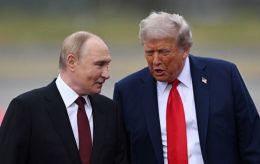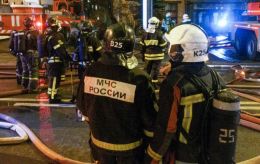Terror, not truce: Why Putin escalates and will Trump react
 Photo: Donald Trump has not yet condemned Vladimir Putin for strikes on Ukraine (Getty Images)
Photo: Donald Trump has not yet condemned Vladimir Putin for strikes on Ukraine (Getty Images)
Despite the start of negotiations to end the war, Russia is only increasing its terror. Targeted missile strikes on Ukrainian cities have supplemented massive drone attacks, and many of the dead this week are children.
RBC-Ukraine explains how this is related to Vladimir Putin's negotiating tactics, why he needs to escalate, and whether there will be a tough response.
Contents
- Drones & missiles: How Russia's attacks on Ukraine changed
- How this relates to peace talks and what Putin is seeking
- Is Putin testing Trump? Will the USA respond tough
Drones + missiles: how Russian attacks on Ukraine have changed
Since the beginning of April, the enemy has returned to striking Ukrainian cities with cruise and ballistic missiles. The most recent combined attack using Shaheds and various types of missiles was recorded a month ago, on March 7. And the ballistic missile strikes on Kyiv took place on February 12, 2025.
During this time, Russia launched more than a hundred attack drones and imitators every day. According to The Telegraph, since February 18, when the first round of talks took place in Saudi Arabia, it launched 4,776 UAV strikes, compared to 3,148 the month before.
Since then, several more rounds of US-Russian talks have occurred, during which Ukraine agreed to an unconditional 30-day ceasefire. Moscow did not reject the idea, but put forward its conditions. Today, the ban on strikes on energy facilities is conditionally in effect, and the “naval truce” is still being negotiated.
And there are no signs that Russia is really ready to move toward peace. Figures show that before the Riyadh meeting, Ukraine was attacked by an average of 101 drones per day, compared to 154 per day afterwards, a 52.5% increase. The attacks were particularly intense on the days when US President Donald Trump publicly criticized Ukrainian leader Volodymyr Zelenskyy at the White House and Washington suspended the transfer of necessary intelligence. Moreover, the drone attacks became more effective, in part because the Shahids began to enter targets by the dozens, gathering in a “carousel” at high altitude.
On April 2, Russian troops hit an infrastructure facility in Kryvyi Rih with ballistic missiles. As a result, four people were killed, including two employees of a car wash. Two days later, the enemy cynically attacked a residential neighborhood with an Iskander with a cluster munition, killing 18 people (including 9 children) and injuring more than 70. Another civilian became a victim of a drone attack on April 4.
Today, Kyiv and Kyiv region came under ballistic missile attack. According to the latest information, six ballistic missiles were launched, the type of which is being established. A business center and warehouses were destroyed in the capital, and there were several fires. So far, one person has been reported dead and three wounded.

Photo: The aftermath of the April 6 ballistic attack on Kyiv (t.me/dsns_telegram)
According to Yurii Ihnat, head of the communications department of the Ukrainian Air Force Command, one missile was shot down, while others attacked targets in the Kyiv region.
“We see that with the advent of Patriot systems, we started to show good results, shooting down Daggers and Iskanders. Now it is more difficult to do so because the enemy is also modernizing ballistic missiles. Ukraine shares information with its partners so that they take it into account and make their weapons more effective. This applies to the Patriot, NASAMS, IRIS-T, and SAMP-T systems. I would like NASAMS and IRIS-T to be able to counter the ballistic threat, but now only the Patriot system is available,” he said.
How this relates to peace talks and what Putin is seeking
President Zelenskyy emphasizes that the number of air attacks is increasing. And such attacks are Putin's response to international diplomatic efforts. According to him, the United States, Europe, and the whole world have seen that Russia is going to continue to fight and kill.
Ballistic missile attacks on cities are nothing but terrorism at its worst, Ignat emphasizes, regardless of whether the missile is loaded with cluster or high-explosive munitions.
“In any case, hitting cities and killing Ukrainians, and then hiding behind their 'achieved goals', is simply incomprehensible to anyone in Ukraine or anyone in the civilized world. We have seen the terrible consequences of ballistics... Kharkiv, Dnipro, Zaporizhzhia, Kryvyi Rih, Kyiv, and other cities. Every time they talk about some restaurants and hotels where they “destroy Western instructors, military, generals, high-ranking Western officials.” In reality, we see where they hit and who died,” he added.
Oleksandr Musiienko, a soldier of the Ukrainian Armed Forces Territorial Defense Forces and a military expert, notes that Russia is now relying on a campaign of massive air terror.
“If we look at the frequency of drone attacks, since the beginning of the so-called negotiation process, Russia has only increased its air strikes. At the same time, it is alleged that such strikes should be stopped, at least if we talk about energy facilities. But this is not the case,” he said in a commentary to RBC-Ukraine.
According to him, Putin's goal is to demoralize Ukrainian society, undermine the will to resist, and get concessions from the Ukrainian authorities so that they make painful compromises on the way to a complete ceasefire. And there are no optimistic predictions for Ukraine that the tactics will change. Musienko is confident that the Russians will continue their aerial terror, based on their capabilities.
“Russia has started using fewer missiles than in 2024 or 2022. However, the use of drones has increased, and the curve has gone up. I think they will be relying on drones and targeted ballistic missile strikes - one, two, three missiles - in the future,” the source added.
Is Putin testing Trump? Will the USA respond tough
A week ago, US President Donald Trump said he was “very angry” with Putin over his position on the ceasefire in Ukraine and threatened to impose secondary sanctions on countries that buy Russian oil. Later, Fox News clarified that Trump was frustrated with Putin's actions in delaying the negotiation process.
After meeting with the American leader, Finnish President Alexander Stubb said that his patience was running out and that Senate Republicans were preparing a large-scale package of sanctions against Russia. President Zelenskyy also counts on signals from America when, after each Russian attack, he says that it is necessary to put pressure on Putin rather than conduct abstract negotiations.
The weak response to the tragedy in Kryvyi Rih has only exacerbated this point. While European partners condemned Putin, US Ambassador to Ukraine Bridget Brink wrote a lengthy post saying that such consequences should end the war. Zelenskyy criticized her for being afraid even to say the word “Russian” about the missile that killed nine children and nine adults. Reacting to today's strike on Kyiv, Brink wrote about “ballistic and cruise missiles from Russia.”
Oleksandr Musiienko does not expect any urgent statements from Trump.
“As far as I know from media reports, he is currently playing golf at his residence in Florida. So, he hasn't had any reaction. Although, I think there should have been. Because it is the United States negotiating with Russia, and it is Russia that promised the United States in Saudi Arabia to at least reach an energy truce (not to hit energy facilities), which it is violating,” the expert noted.
At the same time, he sees a positive signal in Brink's post today.
“Zelenskyy rightly reproached the ambassador for not saying that it was a Russian missile that flew to Kryvyi Rih. After the attack on Kyiv, we see that the situation has changed. She mentioned Russian cruise and ballistic missiles in her post, which resulted in explosions, destruction and fires. The situation is changing, but Putin is really testing Trump's patience. And so far, in this sense, the American president has demonstrated that he is still willing to be patient, unfortunately,” the source added.
Sources: the Ukrainian Air Force's summary, statements by Yurii Ihnat, Head of the Communications Department of the Ukrainian Air Force Command, President of Ukraine Volodymyr Zelenskyy, The Telegraph, and a commentary by Oleksandr Musiienko, a military expert and serviceman of the Ukrainian Territorial Defense Forces.

